MERCEDES-BENZ R-CLASS FAMILY TOURER 2013 Owners Manual
Manufacturer: MERCEDES-BENZ, Model Year: 2013, Model line: R-CLASS FAMILY TOURER, Model: MERCEDES-BENZ R-CLASS FAMILY TOURER 2013Pages: 364, PDF Size: 28.68 MB
Page 341 of 364
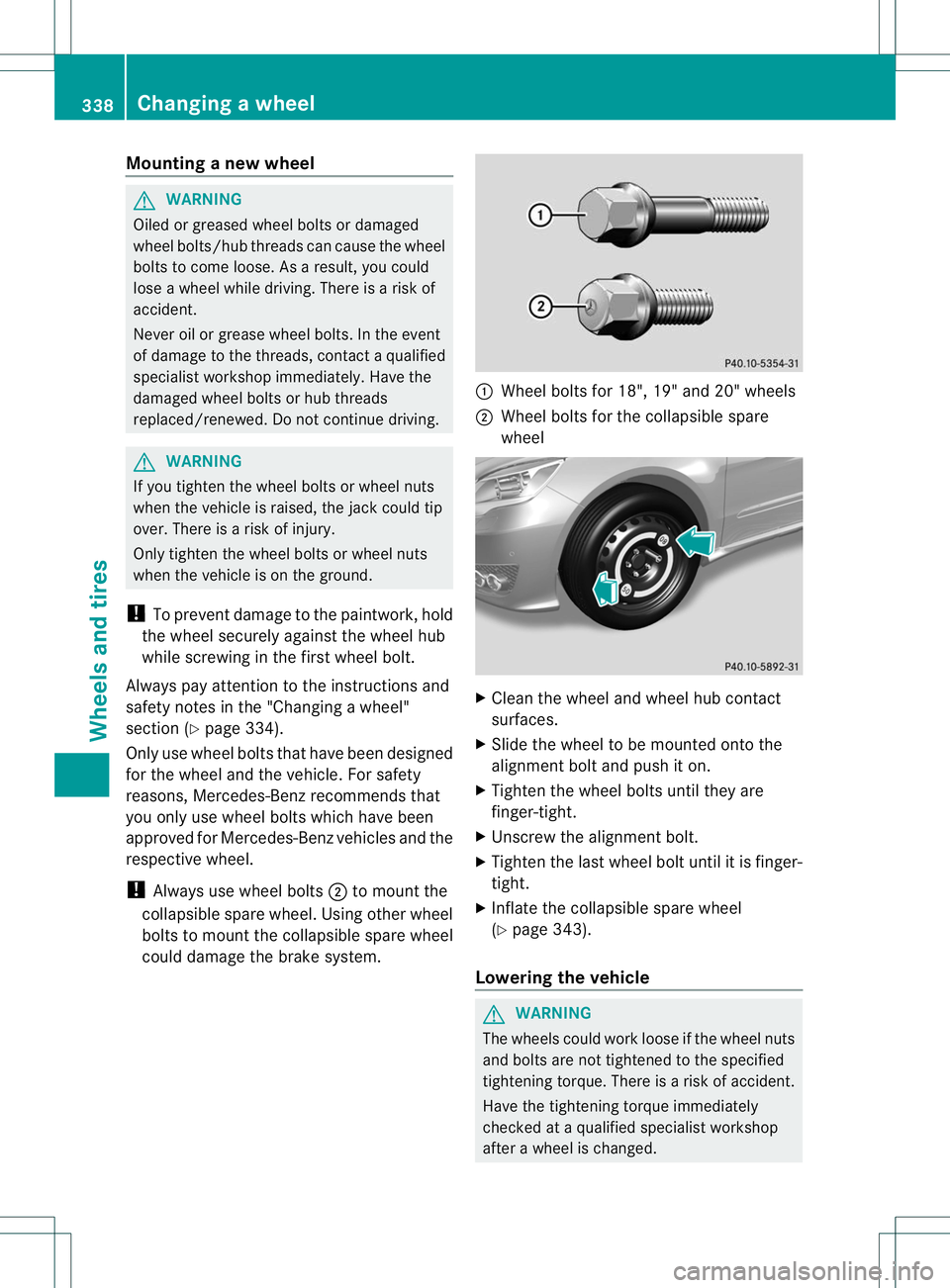
Mounting
anew wheel G
WARNING
Oiled or greased wheel bolts or damaged
wheel bolts/hub threads can cause the wheel
bolts to come loose .As a result, you could
lose a wheel while driving. There is a risk of
accident.
Never oil or grease wheel bolts. In the event
of damage to the threads, contact a qualified
specialist workshop immediately.H ave the
damaged wheel bolts or hub threads
replaced/renewed. Do notc ontinue driving.G
WARNING
If you tighten the wheel bolts or wheel nuts
when the vehicle is raised, the jack could tip
over. There is a risk of injury.
Only tighten the wheel bolts or wheel nuts
when the vehicle is on the ground.
! To prevent damage to the paintwork, hold
the wheel securely against the wheel hub
while screwing in the first wheel bolt.
Always pay attention to the instructions and
safety notes in the "Changing a wheel"
section (Y page 334).
Only use wheel bolts that have been designed
for the wheel and the vehicle. For safety
reasons, Mercedes-Benz recommends that
you only use wheel bolts which have been
approved for Mercedes-Benz vehicles and the
respective wheel.
! Always use wheel bolts ;to mount the
collapsible spare wheel. Using other wheel
bolts to mount the collapsible spare wheel
could damage the brake system. :
Wheel bolts for 18", 19" and 20" wheels
2 Wheel bolts for the collapsible spare
wheel X
Clean the wheel and wheel hub contact
surfaces.
X Slide the wheel to be mounted onto the
alignment bolt and push it on.
X Tighten the wheel bolts until they are
finger-tight.
X Unscrew the alignment bolt.
X Tighten the last wheel bolt until it is finger-
tight.
X Inflate the collapsible spare wheel
(Y page 343).
Lowering the vehicle G
WARNING
The wheels could work loose if the wheel nuts
and bolts are not tightened to the specified
tightening torque. There is a risk of accident.
Have the tightening torque immediately
checked at a qualified specialist workshop
after a wheel is changed. 338
Changing
awheelWheels and tires
Page 342 of 364

!
Inflate the collapsible spare wheel using
the tire inflation compressor before
lowering the vehicle. The wheel rim could
otherwise be damaged. X
Place the ratchet wrench onto the hexagon
nut of the jack so that the letters ABare
visible.
X Turn the ratchet wrench until the vehicle is
once agains tanding firml yonthe ground.
X Place the jack to one side.
X Tighten the wheel bolts evenly in a
crosswise pattern in the sequence
indicated ( :toA). The tightening torque
must be 110 lb-ft (150 Nm) .
X Turn the jack back to its initial position.
X Stow the jack and the rest of the tire-
change tool kit in the stowage well under
the cargo compartment floor again.
X Check the tire pressure of the newly
installed wheel and adjust it if necessary.
Observe the recommended tire pressure
(Y page 316).
i Vehicles with tire pressure monitor: all
wheels mounted must be equipped with
functioning sensors. Wheel and tire combinations
General notes
! For safety reasons, Mercedes-Benz
recommends that you only use tires and
wheels which have been approved by Mercedes-Benzs
pecifically for your
vehicle.
These tires have been specially adapted for
use with the control systems, such as ABS
or ESP ®
, and are marked as follows:
R MO =Mercedes-BenzO riginal
R MOE =Mercedes-BenzO riginal Extended
(tires featuring run-flat characteristics)
R MO1 =Mercedes-BenzO riginal (only
certain AMG tires)
Mercedes-Benz Original Extended tires
may only be used on wheels that have been
specifically approved by Mercedes-Benz.
Only use tires, wheels or accessories
tested and approved by Mercedes-Benz.
Certain characteristics, e.g. handling,
vehicle noise emissions or fuel
consumption, may otherwise be adversely
affected. In addition, when driving with a
load, tire dimension variations could cause
the tires to come into contact with the
bodywork and axle components. This could
result in damage to the tires or the vehicle.
Mercedes-Benz accepts no liability for
damage resulting from the use of tires,
wheels or accessories other than those
tested and approved.
Information on tires, wheels and approved
combinations can be obtained from any
qualified specialist workshop.
! Retreaded tires are neither tested nor
recommended by Mercedes-Benz, since
previous damage cannot always be
detected on retreaded tires. As a result,
Mercedes-Benz cannot guarantee vehicle
safety if retreaded tires are mounted. Do
not mount used tires if you have no
information about their previous usage.
Overview of abbreviations usedint he
following tire tables:
R BA: both axles
R FA: front axle
R RA: rear axle Wheel and tire combinations
339Wheels and tires Z
Page 343 of 364
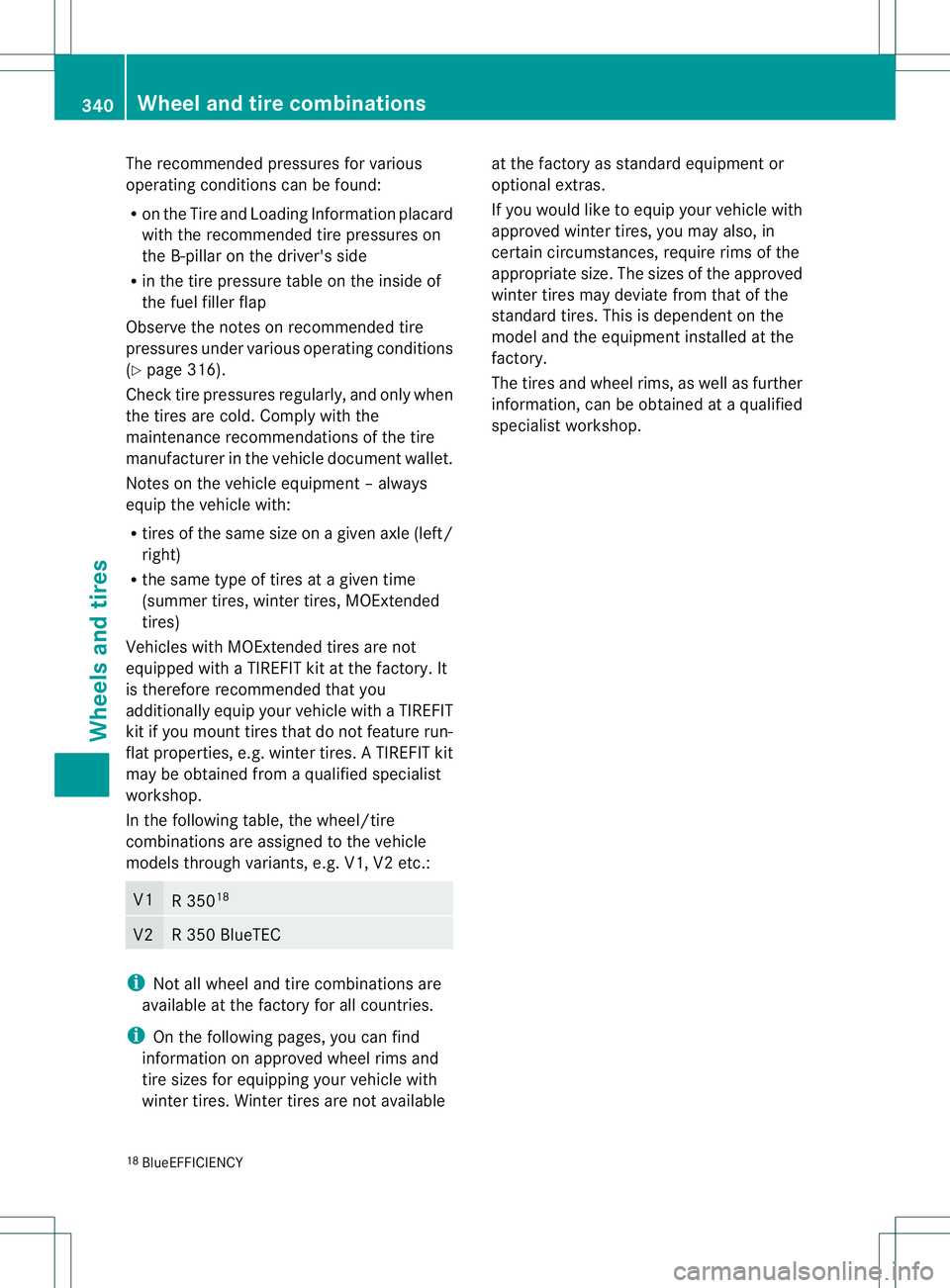
The recommended pressures for various
operating conditions can be found:
R
on the Tire and Loading Information placard
with the recommended tire pressures on
the B-pillar on the driver's side
R in the tire pressure table on the inside of
the fuel filler flap
Observe the notes on recommended tire
pressures under various operating conditions
(Y page 316).
Check tire pressures regularly, and only when
the tires are cold. Comply with the
maintenance recommendations of the tire
manufacturer in the vehicle document wallet.
Notes on the vehicle equipment –always
equip the vehicle with:
R tires of the same size on a given axle (left/
right)
R the same type of tires at a given time
(summer tires, winter tires, MOExtended
tires)
Vehicles with MOExtended tires are not
equipped with a TIREFIT kit at the factory. It
is therefore recommended that you
additionally equip your vehicle with a TIREFIT
kit if you mountt ires that do not feature run-
flat properties, e.g. winter tires. ATIREFIT kit
may be obtained from a qualified specialist
workshop.
In the following table, the wheel/tire
combinations are assigned to the vehicle
models through variants, e.g. V1, V2 etc.: V1
R 350
18 V2 R 350 BlueTEC
i
Not all wheel and tire combinations are
available at the factory for all countries.
i On the following pages, you can find
information on approved wheelr ims and
tire sizes for equipping your vehicle with
winter tires. Winter tires are not available at the factory as standard equipmen
tor
optional extras.
If you would like to equip your vehicle with
approved winter tires, you may also, in
certain circumstances, require rims of the
appropriate size. The sizes of the approved
winter tires may deviate from that of the
standard tires. This is dependent on the
model and the equipment installed at the
factory.
The tires and wheel rims, as well as further
information, can be obtained at a qualified
specialist workshop.
18 BlueEFFICIENCY 340
Wheel and tire combinationsWheels and tires
Page 344 of 364

Tires
All-weather tires R19
Tires Allo
ywheels V1 V2
BA: 255/50 R19 107 H XL M+S BA: 8.0 J x 19 H2
Wheel offset: 2.64 in (67 mm) # #
BA: 255/50 R19 107 H XL
M+SMOExtended
19 BA: 8.0 J x 19 H2
Wheel offset: 2.64 in (67 mm) # #
BA: 255/50 R19 107 H XL M+S BA: 8.5 J x 19 H2
Wheel offset: 2.52 in (64 mm) #
—
R20
Tires Alloy wheels V1 V2
BA: 265/45 R20 108 H XL M+S
20 BA: 9.0 J x 20 H2
Wheel offset: 2.36 in (60 mm) #
—
Winter tires
R18
Tires Alloy wheels V1 V2
BA: 255/55 R18 105 H M+S
i BA: 8.0 J x 18 H2
Wheel offset: 2.64 in (67 mm) #
—
R19
Tires Alloy wheels V1 V2
BA: 255/50 R19 107 H XL M+Si BA: 8.0 J x 19 H2
Wheel offset: 2.64 in (67 mm) # #
BA: 255/50 R19 107 H XL
M+SiMOExtended
19 BA: 8.0 J x 19 H2
Wheel offset: 2.64 in (67 mm) # #
BA: 255/50 R19 107 H XL M+Si BA: 8.5 J x 19 H2
Wheel offset: 2.52 in (64 mm) #
—
19
MOExtended tires (tires featuring run-fla tcharacteristics) only in combination with an activated tire pressure
loss warning system.
20 Use of snow chains not permitted. Observe the notes under "Snow chains". Wheel and tire combinations
341Wheels and tires Z
Page 345 of 364
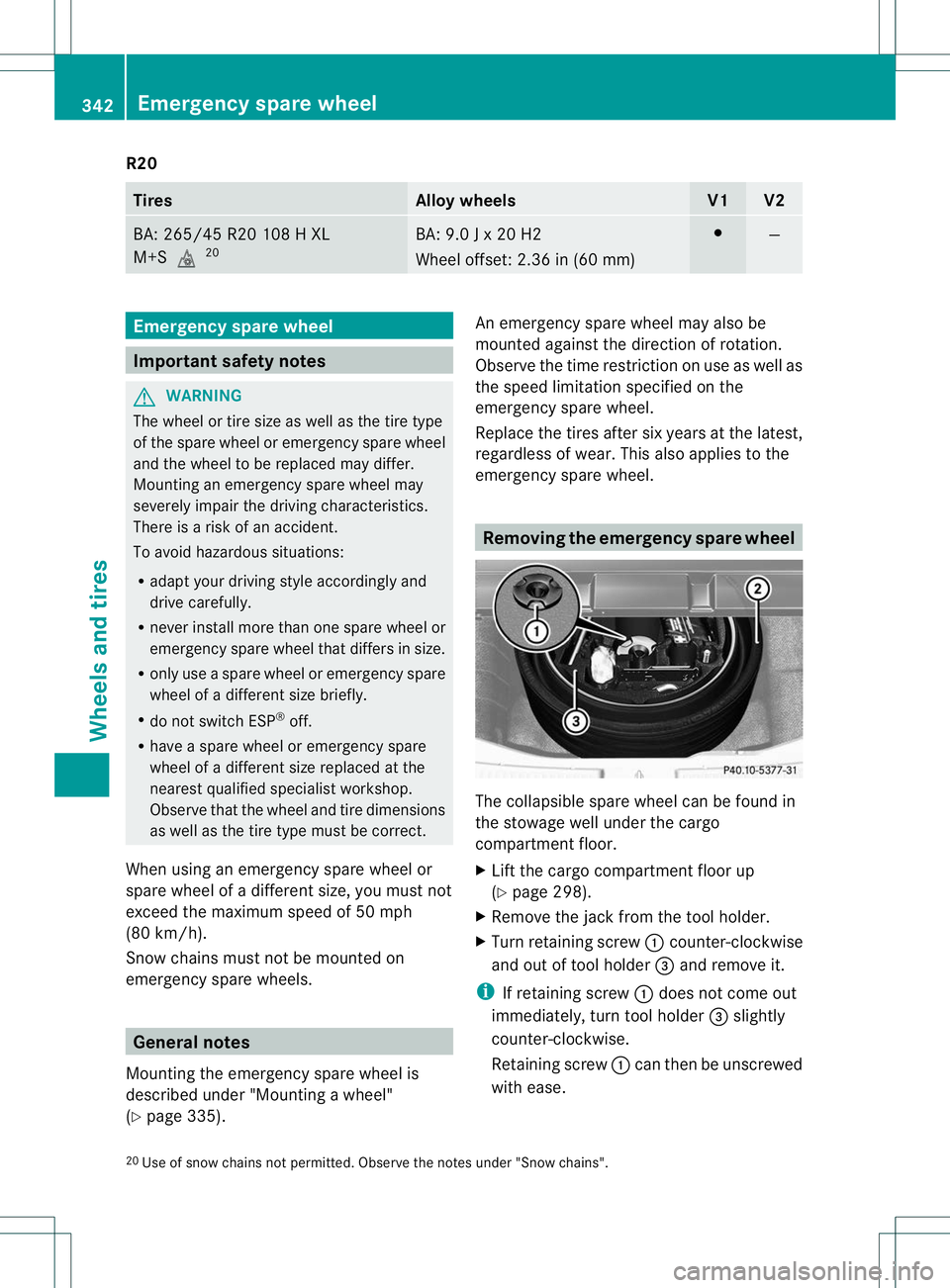
R20
Tires Alloyw
heels V1 V2
BA: 265/45 R20 108 H XL
M+Si
20 BA: 9.0 J x 20 H2
Wheel offset: 2.36 in (60 mm) #
—
Emergency spare wheel
Important safety notes
G
WARNING
The wheel or tire size as well as the tire type
of the spare wheel or emergency spare wheel
and the wheel to be replaced may differ.
Mounting an emergency spare wheel may
severely impair the driving characteristics.
There is a risk of an accident.
To avoid hazardous situations:
R adapt yourd riving style accordingly and
drive carefully.
R never install more than one spare wheel or
emergency spare wheel that differs in size.
R only use a spare wheel or emergency spare
wheel of a different size briefly.
R do not switch ESP ®
off.
R have a spare wheel or emergency spare
wheel of a different size replaced at the
nearest qualified specialist workshop.
Observe that the wheel and tire dimensions
as well as the tire type must be correct.
When using an emergency spare wheel or
spare wheel of a different size, you must not
exceed the maximum speed of 50 mph
(80 km/h).
Snow chains must not be mounted on
emergency spare wheels. General notes
Mounting the emergency spare wheel is
described under "Mounting a wheel"
(Y page 335). An emergency spare wheel may also be
mounted against the direction of rotation.
Observe the time restriction on use as well as
the speed limitation specified on the
emergency spare wheel.
Replace the tires after six years at the latest,
regardless of wear. This also applies to the
emergency spare wheel.
Removing the emergency spare wheel
The collapsible spare wheel can be found in
the stowage well under the cargo
compartment floor.
X
Lift the cargo compartment floor up
(Y page 298).
X Remove the jack from the tool holder.
X Turn retaining screw :counter-clockwise
and out of tool holder =and remove it.
i If retaining screw :does not come out
immediately, turn tool holder =slightly
counter-clockwise.
Retaining screw :can then be unscrewed
with ease.
20 Use of snow chains not permitted. Observe the notes under "Snow chains". 342
Emergency spare wheelWheels and tires
Page 346 of 364
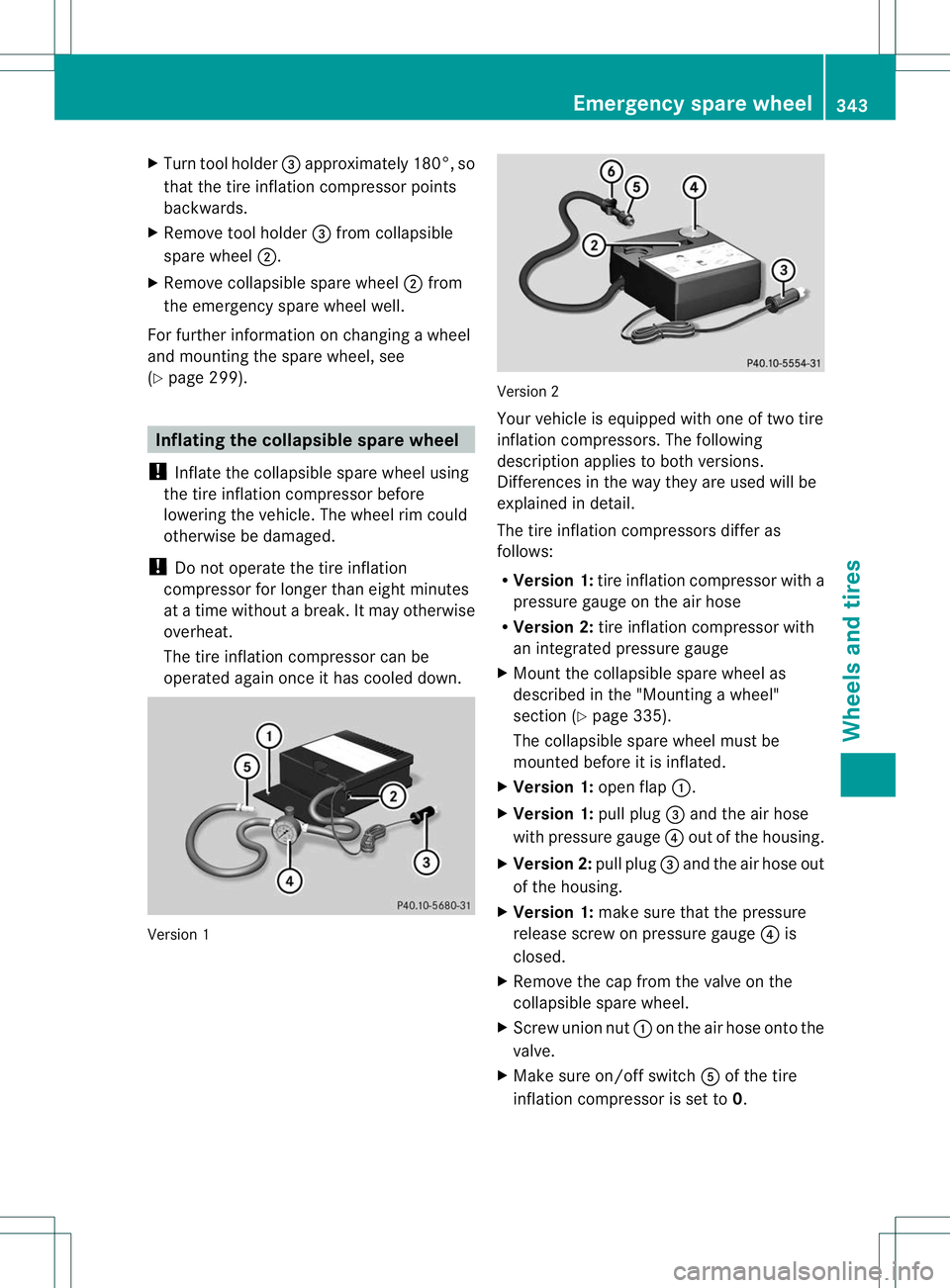
X
Turn tool holder =approximately 180°, so
that the tire inflation compressor points
backwards.
X Remove tool holder =from collapsible
spare wheel ;.
X Remove collapsible spare wheel ;from
the emergency spare wheel well.
For further information on changing a wheel
and mounting the spare wheel, see
(Y page 299). Inflating the collapsible spare wheel
! Inflate the collapsible spare wheel using
the tire inflation compressor before
lowering the vehicle. The wheel rim could
otherwise be damaged.
! Do not operate the tire inflation
compressor for longer than eight minutes
at a time without a break. It may otherwise
overheat.
The tire inflation compressor can be
operated again once it has cooled down. Version 1 Version 2
Your vehicle is equipped with one of two tire
inflation compressors. The following
description applies to both versions.
Differences in the way they are used will be
explained in detail.
The tire inflation compressors differ as
follows:
R
Version 1: tire inflation compressor with a
pressure gauge on the air hose
R Version 2: tire inflation compressor with
an integrated pressure gauge
X Mount the collapsible spare wheel as
described in the "Mounting a wheel"
section (Y page 335).
The collapsible spare wheel must be
mounted before it is inflated.
X Version 1: open flap:.
X Version 1: pull plug=and the air hose
with pressure gauge ?out of the housing.
X Version 2: pull plug=and the air hose out
of the housing.
X Version 1: make sure that the pressure
release screw on pressure gauge ?is
closed.
X Remove the cap from the valve on the
collapsible spare wheel.
X Screw union nut :on the air hose onto the
valve.
X Make sure on/of fswitch Aof the tire
inflatio ncompressor is set to 0. Emergency spare wheel
343Wheels and tires Z
Page 347 of 364
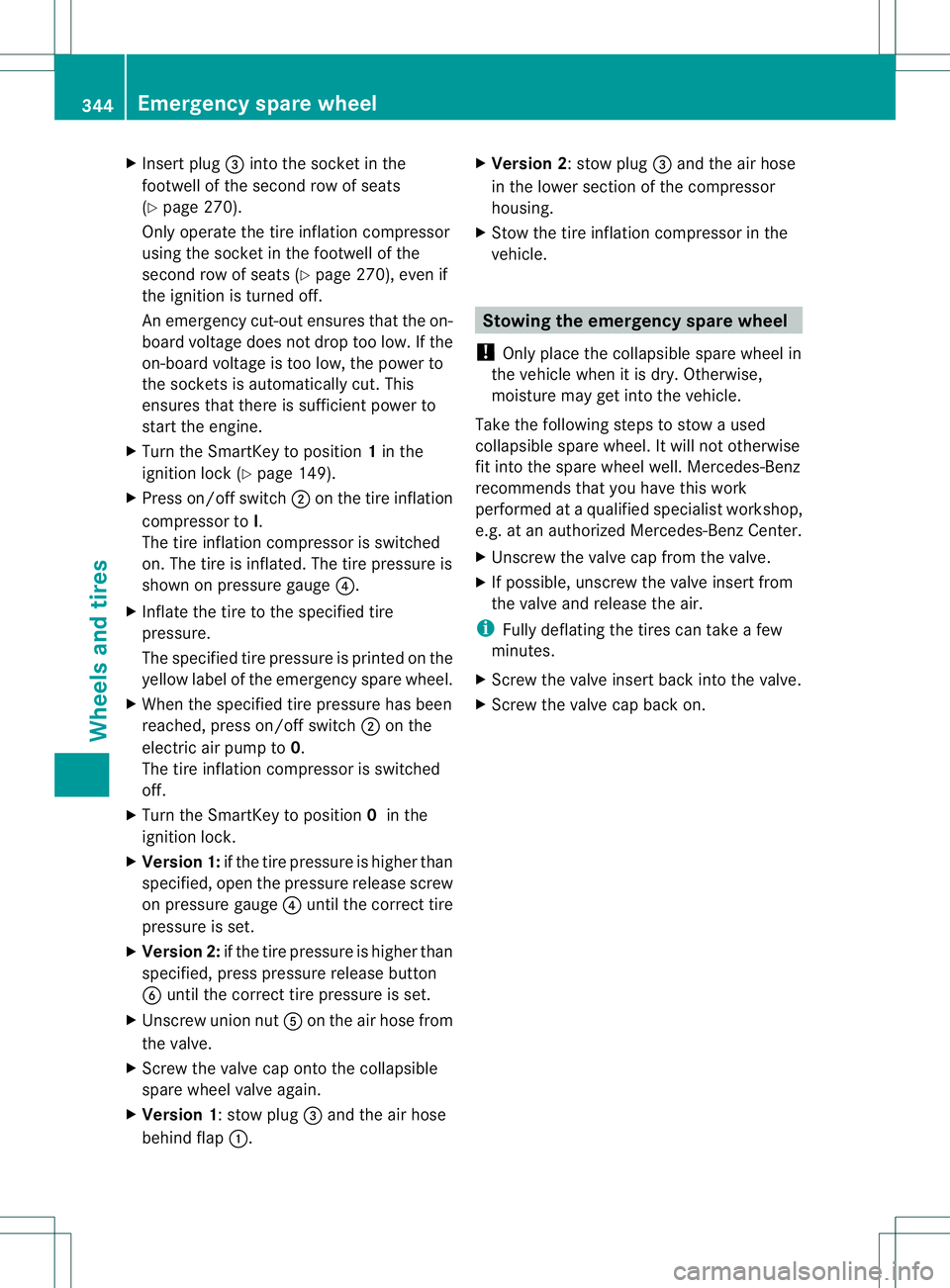
X
Insert plug 3into the socket in the
footwell of the second row of seats
(Y page 270).
Only operate the tire inflatio ncompressor
using the socket in the footwell of the
second row of seats (Y page 270), even if
the ignition is turned off.
An emergency cut-out ensures that the on-
board voltage does not drop too low. If the
on-board voltage is too low, the power to
the sockets is automatically cut. This
ensures that there is sufficient power to
start the engine.
X Turn the SmartKey to position 1in the
ignition lock (Y page 149).
X Press on/offs witch;on the tire inflation
compressor to I.
The tire inflatio ncompressor is switched
on. The tire is inflated. The tire pressure is
shown on pressure gauge ?.
X Inflate the tire to the specified tire
pressure.
The specified tire pressure is printed on the
yellow label of the emergency spare wheel.
X When the specified tire pressure has been
reached, press on/offs witch2on the
electric air pump to 0.
The tire inflatio ncompressor is switched
off.
X Turn the SmartKey to position 0in the
ignition lock.
X Version 1: if the tire pressure is higher than
specified, open the pressure release screw
on pressure gauge 4until the correct tire
pressure is set.
X Version 2: if the tire pressure is higher than
specified, press pressure release button
6 until the correct tire pressure is set.
X Unscrew union nut Aon the air hose from
the valve.
X Screw the valve cap ontot he collapsible
spare wheel valve again.
X Version 1:s tow plug=and the ai rhose
behind flap :. X
Version 2:s tow plug=and the ai rhose
in the lower section of the compressor
housing.
X Stow the tire inflation compressor in the
vehicle. Stowing the emergency sparew
heel
! Only place the collapsible spare wheel in
the vehicle whe nitis dry. Otherwise,
moisture may get into the vehicle.
Take the following steps to stow a used
collapsible spare wheel. It will not otherwise
fit into the spare wheel well.M ercedes-Benz
recommends that you have this work
performed at a qualified specialist workshop,
e.g. at an authorized Mercedes-BenzC enter.
X Unscrew the valve cap from the valve.
X If possible, unscrew the valve insert from
the valve and release the air.
i Fully deflating the tires can take a few
minutes.
X Screw the valve insert back into the valve.
X Screw the valve cap back on. 344
Emergency spare wheelWheels and tires
Page 348 of 364

:
Guides
; Collapsible spare wheel
In the spare wheel well, there are two
guides :to keep the collapsible spare wheel
in place.
X Lay collapsible spare wheel ;in the
emergency spare wheel well.
i Make sure that collapsible spare
wheel ;is positioned on guides :
precisely.
X Lay the tool holde rincollapsible spare
wheel ;so that the tire inflation
compressor is pointing towards the tailgate
(Y page 298).
X Turn tool holder approximately 180° so
that the tire inflation compressor points
forwards.
The tool holder should now be positioned
as stated in the instructions regarding the
installation position. X
Turn the retainer screw on the collapsible
spare wheel clockwise into the tool holder
as far as it will go.
X Stow the jack in the vehicle tool kit. Emergency spare wheel
345Wheels and tires Z
Page 349 of 364
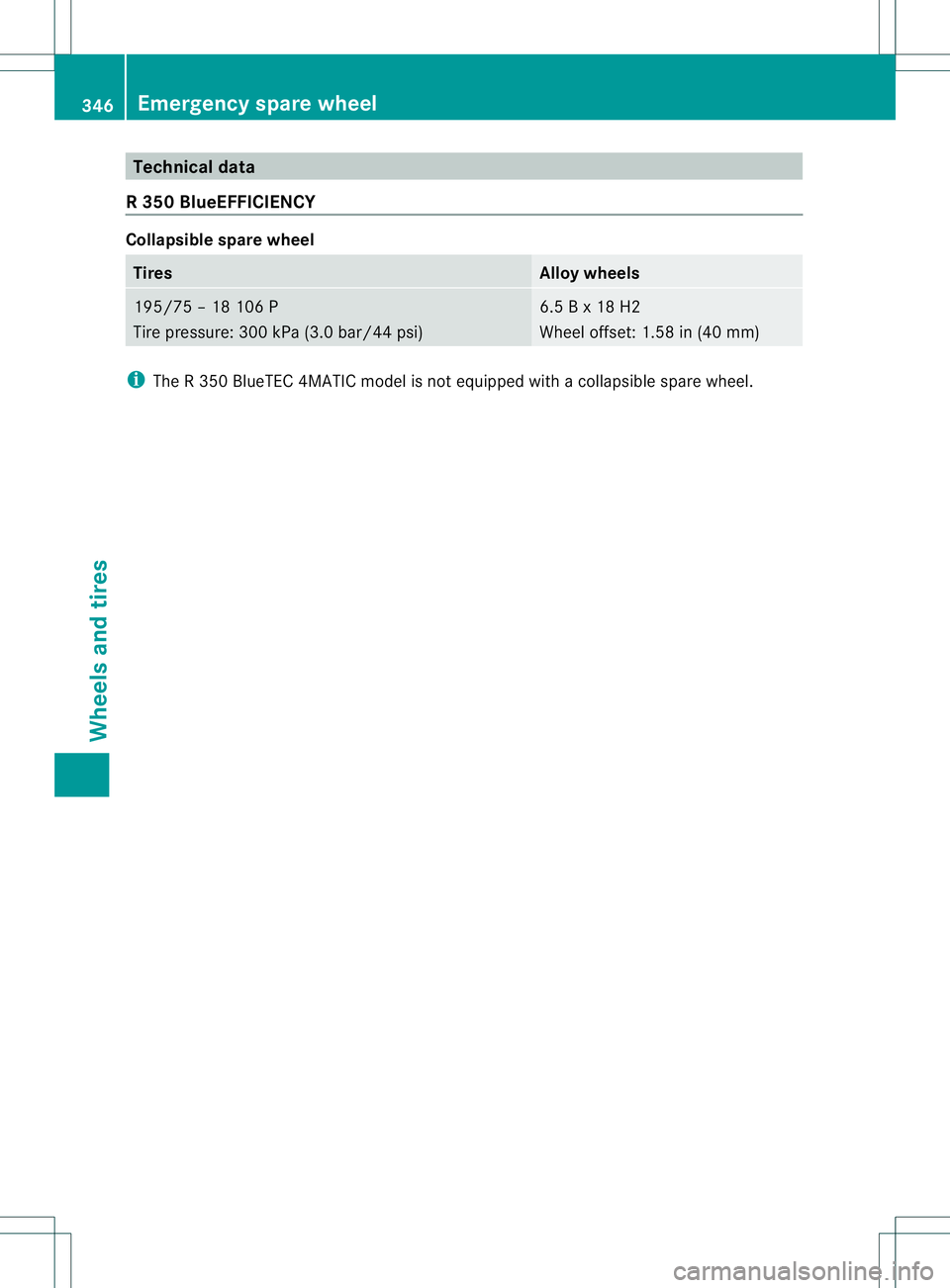
Technical data
R3 50 BlueEFFICIENCY Collapsible spare wheel
Tires Alloy wheels
195/75 – 18 106 P
Tire pressure: 300 kPa (3.0 bar/44 psi) 6.5 B x 18 H2
Wheel offset: 1.58 in (40 mm)
i
The R 350 BlueTEC 4MATIC model is not equipped with a collapsible spare wheel. 346
Emergency spare wheelWheels and tires
Page 350 of 364
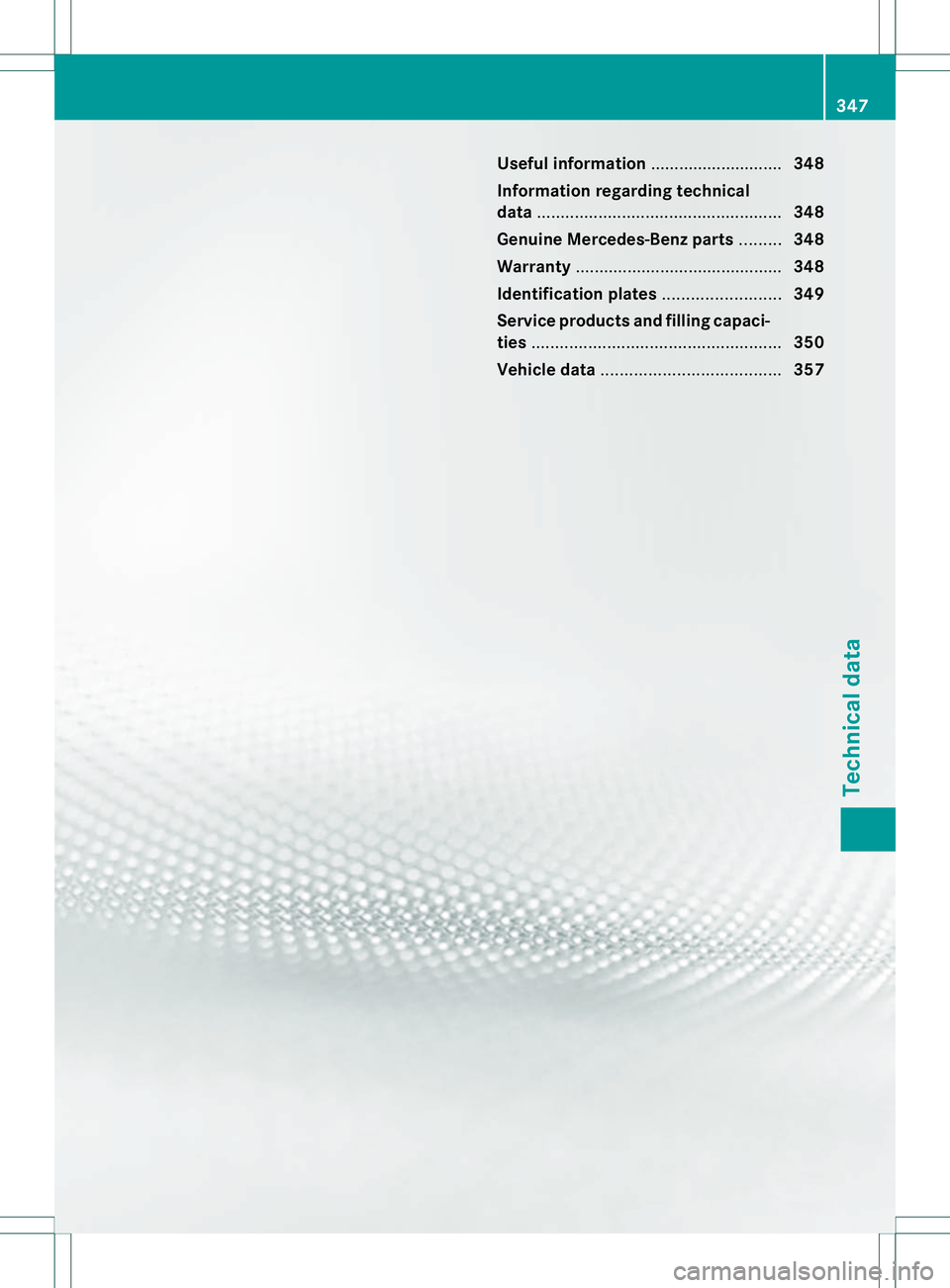
Useful information
............................348
Information regarding technical
data .................................................... 348
Genuine Mercedes-Benz parts .........348
Warranty ............................................ 348
Identification plates .........................349
Service products and filling capaci-
ties ..................................................... 350
Vehicle data ...................................... 357 347Technical data